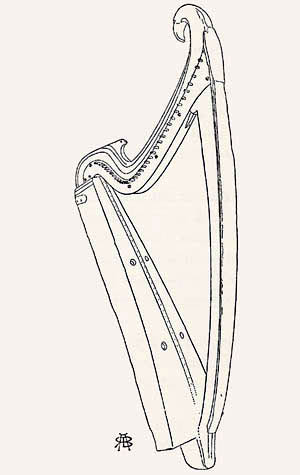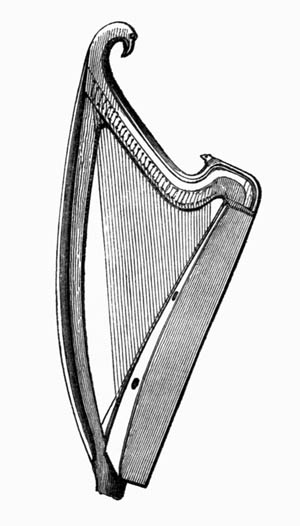
Drawing by Robert Bruce Armstrong,
from The Irish and Highland Harps
| Feature | Detail |
|---|---|
| Date | Probably 18th century (though late 17th century is possible) |
| String Count | 36 |
| Height | 158 cm (62 inches) |
| Soundbox | Hollowed out from a single block (“willow”), maximum width 34 cm. (13½ inches) |
| Current Location | The National Museum of Ireland, Collins Barracks, Dublin |
This harp was formerly in the collection of the Royal Irish Academy.
For Robert Bruce Armstrong’s account of this harp, see The Irish and Highland Harps pages 82 and 83. It includes the drawing reproduced above, as well as a rather brief description and measurements. The other illustration that appears below is probably the earliest published depiction of this harp, and can be found on page 246 of William Robert Wilde’s A Descriptive Catalogue of the Antiquities in the Museum of the Royal Irish Academy 1856 (published 1857), where it is labeled "Fig. 159". On the previous page Wilde gives the following brief description:

Figure 159 from William Robert Wilde
“[It] is 5 feet 2½ inches high, and 2 feet 8 inches broad at the widest portion. It had thirty–six wire strings; the pins are iron, inserted into a brass plate. The plate upon the sounding–board is also brass. The head of an eagle has been carved upon the top of the key-piece, and the figure of a rabbit surmounts the lower portion of it. This harp was procured with the collection of the late Major Sirr, and is said to have belonged to a bard of the O’Neills; but is probably not older than 250 years.”
At some time in the past the projecting block, or foot, of this harp broke away from the end of the soundbox. This was subsequently fixed back into position with copper wire, and the outside of this repair (the area around the projecting block and the end of the soundbox) was covered with canvas which had been glued on.[1] Although Armstrong makes no reference to this in his text, one can deduce from the line–work on his drawing (which was traced from a photograph) that the canvas was in position before he saw it.
[1] This observation made by Michael Billinge from an internal inspection of the soundbox undertaken in 2008.